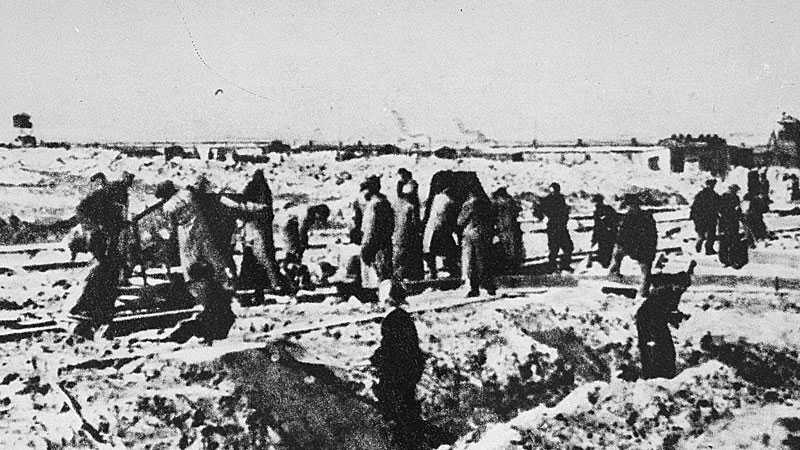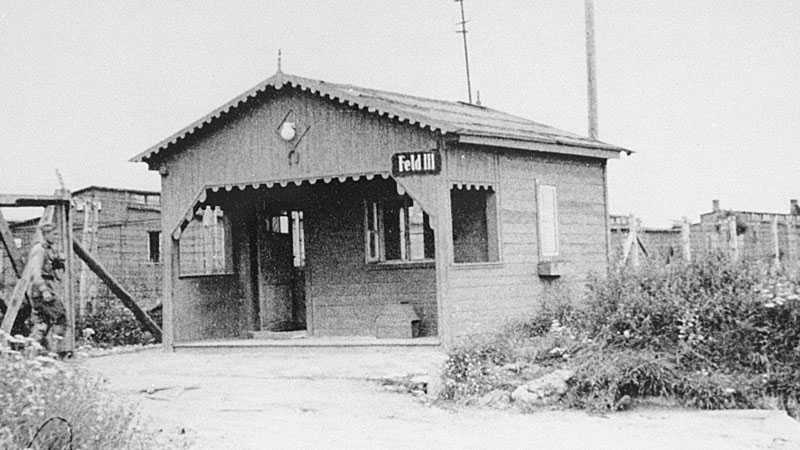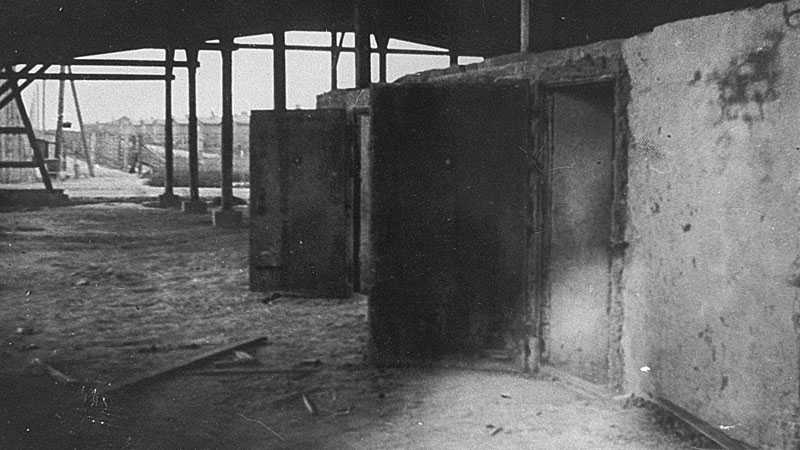
The Nazi concentration camp in Lublin, Majdanek, was realized by Heinrich Himmler’s decision to build concentration camps in the German occupied countries. Visiting Lublin in July 1941, Himmler entrusted Lublin district SS and police commander, Odilo Globocnik, with building a camp for 25 - 50.000 inmates who would be used to work in workshops and construction sites. The camp was original meant to use the prisoners as free workforces for the plans to build a great German empire.
"For evil to flourish, it only requires good men to do nothing".
Simon Wiesenthal

Barbed wire electrical fences

Overview of the Majdanek camp

Prisoner barracks

Forced labour outside the camp

Prisoners were forced to work

Fences and guard towers

One of the many guard houses

The gas chamber at Majdanek

The crematorium at Majdanek

The crematorium ovens

Group of prisoners after liberation
- Barbed wire electrical fences
- Overview of the Majdanek camp
- Prisoner barracks
- Forced labour outside the camp
- Prisoners were forced to work
- Fences and guard towers
- One of the many guard houses
- The gas chamber at Majdanek
- The crematorium at Majdanek
- The crematorium ovens
- Group of prisoners after liberation
History, definition and facts about Majdanek
in July 1942, Himmler visited Belzec, Sobibor, and Treblinka, the three secret extermination camps built specifically for the Nazi German Operation Reinhard planned to eliminate Polish Jewry. These camps had begun operations in March, May, and July 1942, respectively. Subsequently, Himmler issued an order that the deportations of Jews to the camps from the five districts of occupied Poland, which constituted the Nazi General gouvernement, be completed by the end of 1942.
Majdanek was made into a secondary sorting and storage depot at the onset of Operation Reinhard, for property and valuables taken from the victims at the killing centers in Belzec, Sobibor, and Treblinka. However, due to large Jewish populations in south-eastern Poland, including the ghettos at Kraków, Lwów, Zamość and Warsaw, which were not yet "processed",
First prisoners arrive
Majdanek was both a concentration and extermination camp. Originally the camp was intended for prisoners of war. The first prisoners arrived in the fall of 1941. These were 5.000 Russian prisoners of war. The next transports consisted of Polish Jews from the Lublin ghetto and the surrounding area. Besides the Jews, who made up the largest part of the population of Majdanek, many non-Jewish Poles were later imprisoned.
Killing center Majdanek
Majdanek was refurbished as a killing center around March 1942. The gassing was performed in plain view of other inmates, without as much as a fence around the buildings. Another frequent murder method was shootings by the squads of Trawnikis. There are two identical buildings at Majdanek, where Zyklon B was used. Executions were carried out in barrack 41 with the use of crystalline hydrogen cyanide released by the Zyklon B. The same poison gas pellets were used to disinfect prisoner clothing in barrack 42.
The most common form of punishment was lashing, performed publically after the evening roll-call. Prisoners charged with less serious offences were forced to do penalty exercise, stand for hours on end between two rows of eletrical wires or attend disciplinary roll-calls. Further more they could be deprived of meals or be forced to endure the stanchion, a form of punishment where the prisoner was suspended by the wrists of his arms twisted behind his back. The SS were quick to strike and whip inmates, submerge or drown them in basins or sewage pits and turn their dogs on them. More serious offences, including escape attempts, were punishable by hanging.
Forced labour
Due to the pressing need for foreign manpower in the war industry, the Jewish laborers from Poland were originally spared. For a time they were either kept in the ghettos, such as the one in Warsaw (which became a concentration camp after the Warsaw Ghetto Uprising), or sent to labor camps such as Majdanek, where they worked primarily at the Steyr-Daimler-Puch weapons/munitions factory.
By mid-October 1942, the camp held 9.519 registered prisoners, of which 7.468 were Jews, and another 1.884 were non-Jewish Poles. By August 1943, there were 16.206 prisoners in the main camp, of which 9.105 were Jews and 3.893 were non-Jewish Poles. Minority contingents included Belarusians, Ukrainians, Russians, Germans, Austrians, Slovenes, Italians, and French and Dutch nationals. According to the data from the official Majdanek State Museum, 300.000 persons were inmates of the camp at one time or another. The prisoner population at any given time was much lower.
Female SS Guards
From October 1942 onwards, Majdanek also had female overseers. These SS guards, who had been trained at the Ravensbrück concentration camp, included Elsa Ehrich, Hermine Boettcher-Brueckner, Hermine Braunsteiner, Hildegard Lächert, Rosy Suess Elisabeth Knoblich-Ernst, Charlotte Karla Mayer-Woellert, and Gertrud Heise (1942–1944), who were later convicted as war criminals.
Subcamps of Majdanek
Majdanek did not initially have subcamps. These were incorporated in early autumn 1943 when the remaining forced labor camps around Lublin, including Budzyn, Trawniki, Poniatowa, Krasnik, Pulawy, as well as the "Airstrip", and "Lipowa 7" concentration camps became sub-camps of Majdanek.
Red Cross
From February 1943 onwards, the Germans allowed the Polish Red Cross and Central Welfare Council to bring in food items to the camp. Prisoners could receive food packages addressed to them by name via the Polish Red Cross. The Majdanek Museum archives document 10.300 such deliveries.
Letters
Due to the camp's proximity to Lublin, prisoners were able to communicate with the outside world through letters smuggled out by civilian workers who entered the camp. Many of these surviving letters have been donated by their recipients to the camp museum. In 2008 the museum held a special exhibition displaying a selection of those letters.
Liberation of the camp
In late July 1944, with Soviet forces rapidly approaching Lublin, the Germans hastily evacuated the camp. However, the staff had only succeeded in partially destroying the crematoria before Soviet Red Army troops arrived on July 24, 1944, making Majdanek the best-preserved camp of the Holocaust, due to the incompetence of its deputy commander, Anton Thernes. It was the first major concentration camp liberated by Allied forces, and the horrors found there were widely publicised.
Although 1.000 inmates had previously been forcibly marched to Auschwitz (of whom only half arrived alive), the Red Army still found thousands of inmates, mainly POWs, still in the camp, and ample evidence of the mass murder that had occurred there.
Aftermath
Some Nazi personnel of the camp were prosecuted immediately after the war, and some in the decades afterward. In November and December 1944, four SS Men and two kapos were placed on trial; one committed suicide and the rest were hanged on December 3, 1944. The last major, widely publicized prosecution of 16 SS members from Majdanek (Majdanek-Prozess in German) took place from 1975 to 1981 in West Germany. However, of the 1.037 SS members who worked at Majdanek and are known by name, only 170 were prosecuted. This was due to a rule applied by the West German justice system that only those directly involved in the murder process could be charged.
After the war
After the capture of the camp by the Soviet Army, the NKVD (the fomer KGB) retained the ready made facility as a prison for soldiers of the Armia Krajowa (AK, the Home Army resistance) loyal to the Polish Government-in-Exile and the Narodowe Siły Zbrojne (National Armed Forces) opposed to both German and Soviet occupation. The NKVD like the SS before them used the same facilities to imprison and torture Polish patriots.
On August 19, 1944, in a report to the Polish government-in-exile, the Lublin District of the Home Army (AK) wrote: "Mass arrests of the AK soldiers are being carried out by the NKVD all over the region. These arrests are tolerated by the Polish Committee of National Liberation, and AK soldiers are incarcerated in the Majdanek Camp. Losses of our nation and the Home Army are equal to the losses which we suffered during the German occupation. We are paying with our blood."
Among the prisoners at the Majdanek NKVD Camp were Volhynian members of the AK, and soldiers of the AK units which had been moving toward Warsaw to join in the Warsaw Uprising. On August 23, 1944, some 250 inmates from Majdanek were transported to the rail station Lublin Tatary. There, all victims were placed in cattle cars and taken to camps in Siberia and other parts of the Soviet Union.
Memorial Majdanek Museum
In 2016, Majdanek State Museum and its branches, Sobibór and Bełżec, had about 210.000 visitors. This was an increase of 10.000 visitors from the previous year. Visitors include Jews, Poles, and others that wish to learn more about the harsh crimes against humanity.
Real eyewitness testimonies
Hugo Princz - Majdanek survivor
"A warm thank you to the United States Holocaust Memorial Museum for their willingness to help in allowing their testimonies to be featured on my website.
The camp specifications
October 1, 1941 - July 22, 1944
± 300.000
78.000

Red Army
Liberated on: July 22, 1944
"None of us who entered the camp had any warning what so ever of what we were about to see".
Camp commmanders

Karl Otto Koch

Max Koegel

Hermann Florstedt

Martin Gottfried Weiss

Arthur Liebehenschel

